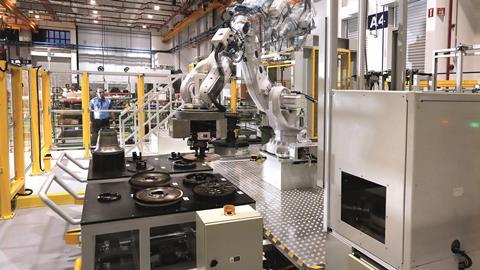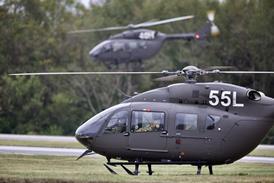The Pratt & Whitney GTF engine family has had one of the most rapid ramp-ups of any engine in history. More than 2,300 GTF-powered aircraft – Airbus A320neo, A220, and Embraer E2 family jets – have entered service since the first example of the next-generation powerplant was delivered just over nine years ago.
But as one contingent of Pratt & Whitney executives have been concentrating on increasing the output of GTF production engines at the facilities of Pratt & Whitney and its partners, another set have had an equally important task – establishing a highly integrated global maintenance, repair and overhaul (MRO) footprint, able to support a more technologically complex product than the International Aero Engines (IAE) V2500 that came before.
There are now 20 GTF MRO network facilities across four continents, three of which are owned wholly or partly by Pratt & Whitney. The rest, many with connections to GTF operators or risk-sharing partners in the engine itself, are “leaders in the MRO industry”, remarks Rob Griffiths, senior vice-president commercial engines operations, who directs the strategic oversight of the company’s worldwide commercial aftermarket services.

There was a 30% growth in GTF MRO output in 2024 and the next few years are expected to see similar boosts as further collaborations and added capacity from new and existing partners comes on stream. “We are continuing to grow to make sure we have the right capacity in place,” says Rick Deurloo, president commercial engines.
Earlier this year, Pratt & Whitney announced agreements with two of its current network partners – Delta TechOps and MTU Aero Engines – to expand their capabilities. Delta TechOps will increase its GTF overhaul output by 30% to 450 engines annually. The Atlanta, Georgia-based provider, which also maintains the PW1100G-JM for Delta Air Lines’ A320neo fleet, joined the GTF network in 2019 and opened a 14,400sq m (155,000sq ft) dedicated GTF facility in 2023.
Meanwhile, MTU – one of the first GTF MRO network partners and responsible for manufacturing several components of the engine, including the low-pressure turbine and the first four stages of the high-pressure compressor – will increase annual capacity across their facilities to up to 600 GTF shop visits across all GTF models, making it one of the largest service providers in the network. Two of MTU’s joint ventures – EME Aero with Lufthansa Technik in Poland and MTU Maintenance in Zhuhai with China Southern Airlines – also carry out GTF maintenance.
Extending reach
Pratt & Whitney has also been expanding its own aftermarket operations. In November, the company and its joint venture partner, Air New Zealand, hosted a groundbreaking event for a 14,000sq m extension to its Christchurch Engine Centre. It will have a capacity of up to 140 GTF engine overhauls by 2032, with the first engine expected to be inducted by the fourth quarter of next year. The engine centre is a long-standing V2500 MRO specialist.
In April, Pratt & Whitney said a $20 million investment in its West Palm Beach Engine Center in Florida would increase its ability to carry out work on GTF engines by 40% by the second half of this year. The facility will also increase its workforce by a quarter. Also last year, Pratt & Whitney officially opened a 4,500sq m expansion of Eagle Services Asia (ESA), jointly run with local concern SIAEC. The move has increased GTF capacity by two-thirds.

Earlier this year, Pratt & Whitney announced the first GTF MRO shop in the Middle East, North Africa and South Asia region with the appointment of Sanad in Abu Dhabi. Sanad’s facility, in the city of Al Ain, is expected to be completed by 2028 and will carry out maintenance and overhauls on all models of the engine.
Two centres in Europe inducted their first GTF engine during the past 12 months. Embraer’s Portuguese subsidiary OGMA, which joined the network in 2020, has capabilities for both the PW1100G-JM for the A320neo family and the E2’s PW1900G. Meanwhile, SR Technics, a long-standing Pratt & Whitney MRO partner, accepted its first GTF for MRO work in 2024.
“Among the network members, cooperation is key,” says Griffiths. “Our objective is to maximise best practices sharing and utilisation, and make sure the capacity we are investing in is right-sized,” he adds. “We have technical specialists at all the sites, supporting them day to day, and we meet as a community periodically. Everything is about supporting the development of overhaul and repair capabilities and improving turn times,” he says.
Challenge ready
The fledgling network has faced an early test with an extensive GTF engine recall to inspect, repair, and replace if necessary certain components manufactured from powdered metals. While acknowledging the impact on customers, Griffiths says the network has responded to the challenge and that AOG (aircraft on ground) levels “have stabilized and should steadily reduce this year”.
He adds: “All of the product improvements are understood and qualified. Now it’s about getting the fixes into the fleet. Engines coming off the production line have the full life parts. The only question now is how fast the supply chain can get the parts into the MRO network.”
Pratt & Whitney has been investing in technologies that directly benefit its MRO network. These include a new additive manufacturing repair for critical GTF components, including a turbine inner case, using a 3D printing method known as directed energy deposition, that will reduce process time by more than 60%. Pratt & Whitney expects to recover $100 million worth of parts over the next five years through the implementation of additive repairs throughout its MRO process.
The innovation was developed by Pratt & Whitney’s North America Technology Accelerator in Jupiter, Florida – a commercial and military aftermarket operations centre of excellence opened last year to develop material restoration and process automation such as digital inspection, adaptive processing and coating and masking for compressor and fan parts, blades, and cases.
The centre complements a similar facility in Singapore, established in 2022, with a focus on robotics, advanced inspection and digital twin processes. Both the Florida and Singapore sites are part of what Pratt & Whitney calls its Industry 4.0 transformation – a dedicated effort across its worldwide manufacturing and MRO footprint to invest and advance technology and operations to maximize efficiency in manufacturing and MRO. Pratt & Whitney recently highlighted one such development project, Alfred, a robot designed to assemble the high-pressure GTF compressor, which has reduced build time by 50% using automation.

With the GTF approaching its 10th anniversary in service, and its MRO network growing by the year, the V2500 engine still remains vital to Pratt & Whitney’s aftermarket business, more than 35 years after its entry into service on the original A320. In April, IAE – which teams Pratt & Whitney with MTU and Japanese consortium JAEC – announced that the V2500 had passed 300 million operational engine flight hours, something Deurloo describes as a “huge milestone”.
“The V2500 still powers around 2,800 aircraft with more than 150 operators, and there is still a lot of life left in the engine. It has world-class durability and retirements remain flat. It powers our business through the aftermarket,” he says. “With 13 facilities, there is an incredible MRO network supporting this fleet.”
When it comes to the GTF, Griffiths insists MRO support remains crucial. “The customer has expectations about the performance of the product, but just as important is the support we provide the customer in terms of value in the aftermarket,” he says. “That is what we are standing behind. We recognize it has been a challenge as we have gone through these early maturity issues, but one thing we have done is invest in the MRO side to ensure we are supporting the fleet.”
Pratt & Whitney at 100

To mark the centenary of Pratt & Whitney, FlightGlobal has partnered with RTX to produce a souvenir special looking at the legacy and future of one of the industry’s most powerful and influential brands.
- 1
- 2
- 3
- 4
- 5
- 6
- 7
- 8
- 9
 Currently
reading
Currently
reading
Pratt & Whitney at 100: MRO – service ready
- 11
- 12
- 13

















































